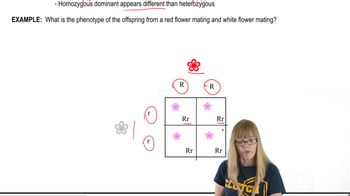Table of contents
- 1. Introduction to Genetics51m
- 2. Mendel's Laws of Inheritance3h 37m
- 3. Extensions to Mendelian Inheritance2h 41m
- 4. Genetic Mapping and Linkage2h 28m
- 5. Genetics of Bacteria and Viruses1h 21m
- 6. Chromosomal Variation1h 48m
- 7. DNA and Chromosome Structure56m
- 8. DNA Replication1h 10m
- 9. Mitosis and Meiosis1h 34m
- 10. Transcription1h 0m
- 11. Translation58m
- 12. Gene Regulation in Prokaryotes1h 19m
- 13. Gene Regulation in Eukaryotes44m
- 14. Genetic Control of Development44m
- 15. Genomes and Genomics1h 50m
- 16. Transposable Elements47m
- 17. Mutation, Repair, and Recombination1h 6m
- 18. Molecular Genetic Tools19m
- 19. Cancer Genetics29m
- 20. Quantitative Genetics1h 26m
- 21. Population Genetics50m
- 22. Evolutionary Genetics29m
2. Mendel's Laws of Inheritance
Monohybrid Cross
Problem 10i
Textbook Question
A male mouse from a true-breeding strain of hyperactive animals is crossed with a female mouse from a true-breeding strain of lethargic animals. (These are both hypothetical strains.) All the progeny are lethargic. In the F₂ generation, all offspring are lethargic. What is the best genetic explanation for these observations? Propose a cross to test your explanation.
 Verified step by step guidance
Verified step by step guidance1
<span>Step 1: Identify the phenotypes and genotypes of the parental generation (P generation). The male mouse is hyperactive, and the female mouse is lethargic. Since they are true-breeding, the male is homozygous for the hyperactive allele (let's denote it as HH) and the female is homozygous for the lethargic allele (let's denote it as LL).</span>
<span>Step 2: Determine the genotype of the F₁ generation. Since all progeny are lethargic, the lethargic trait is dominant. Therefore, the F₁ generation must be heterozygous (HL) and express the lethargic phenotype.</span>
<span>Step 3: Analyze the F₂ generation. Since all offspring in the F₂ generation are lethargic, it suggests that the lethargic allele is dominant and the hyperactive allele is recessive. This implies that the F₁ generation (HL) crossed with itself (HL x HL) results in all lethargic offspring, indicating a possible lethal effect of the homozygous recessive genotype (HH).</span>
<span>Step 4: Propose a test cross to confirm the hypothesis. Cross an F₁ lethargic mouse (HL) with a homozygous hyperactive mouse (HH). If the hypothesis is correct, the offspring should all be lethargic (HL), confirming the lethargic allele's dominance and the recessive lethality of the hyperactive allele.</span>
<span>Step 5: Consider alternative explanations. If the test cross does not yield the expected results, consider other genetic mechanisms such as epistasis or incomplete dominance that might explain the observed phenotypes.</span>
Recommended similar problem, with video answer:
 Verified Solution
Verified SolutionThis video solution was recommended by our tutors as helpful for the problem above
Video duration:
3mPlay a video:
Was this helpful?
Key Concepts
Here are the essential concepts you must grasp in order to answer the question correctly.
True-breeding Strains
True-breeding strains are genetically uniform populations that consistently produce offspring with the same phenotype when self-crossed. In this scenario, the hyperactive male and lethargic female represent two distinct true-breeding strains, which helps establish the genetic basis for the traits being studied. Understanding true-breeding is crucial for predicting the inheritance patterns in subsequent generations.
Recommended video:
Guided course

Drosophila P Element
Dominance and Recessiveness
In genetics, dominance refers to the phenomenon where one allele masks the expression of another allele at the same locus. In this case, if lethargy is a dominant trait, it would explain why all progeny from the cross exhibit lethargy, regardless of the hyperactive male's genotype. Recognizing the dominance relationship between traits is essential for interpreting the results of genetic crosses.
Recommended video:
Guided course

Variations on Dominance
F₂ Generation and Mendelian Ratios
The F₂ generation refers to the second filial generation, which results from crossing two F₁ individuals. According to Mendelian genetics, the expected phenotypic ratio in a typical monohybrid cross is 3:1 for dominant to recessive traits. However, in this case, the observation that all F₂ offspring are lethargic suggests a different inheritance pattern, possibly indicating that lethargy is a trait governed by multiple alleles or epistatic interactions.
Recommended video:
Guided course

F Factor and Hfr

 1:20m
1:20mWatch next
Master Monohybrid Cross with a bite sized video explanation from Kylia Goodner
Start learningRelated Videos
Related Practice


